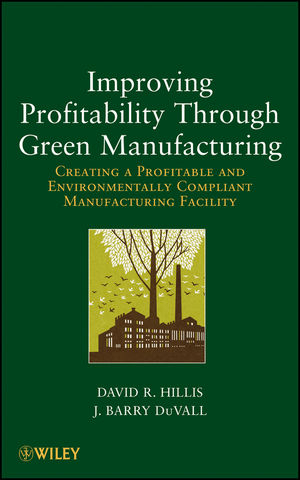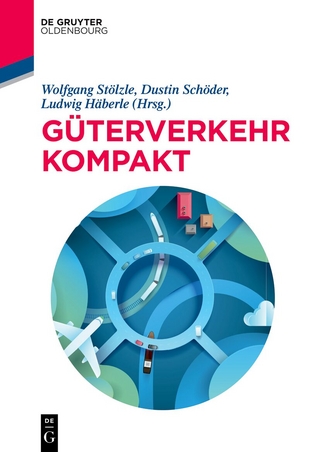
Improving Profitability Through Green Manufacturing
John Wiley & Sons Inc (Verlag)
978-1-118-11125-3 (ISBN)
- Titel z.Zt. nicht lieferbar
- Versandkostenfrei
- Auch auf Rechnung
- Artikel merken
Manufacturers can be green and highly profitable at the same time
Profits do not have to be sacrificed to environmental responsibility, or vice versa. Following this book's tested and proven approach, readers discover how to create and operate manufacturing facilities that are highly profitable while meeting or exceeding the environmental standards of their local community, state, and federal governments. The authors' approach is broad in scope, setting forth the roles and responsibilities of organizational functions such as marketing, product design, manufacturing technology, management, and human resources.
The book begins with an overview explaining why profitability and green manufacturing must be viewed as a single objective.
Next, the book becomes a "how to" guide to creating and maintaining an environmentally compliant and profitable manufacturing operation, with chapters covering:
Manufacturing, waste, and regeneration
Building a decision-making model
Environmental regulation, standards, and profitability
Case studies
Tools used to improve manufacturing operations
The facility
Applying the profitable and compliant process chart
The final chapter is dedicated to a step-by-step approach in the application and use of the profitable and compliant process chart, a core working tool discussed in the book. In this chapter, several actual manufacturing applications, along with their worksheets, are presented to illustrate how this approach can minimize resources and waste. Armed with this comprehensive systems approach, readers will no longer view profitability and green manufacturing as two opposing goals. Instead, they'll have the tools and knowledge needed to create and maintain a manufacturing operation that is both profitable and green.
DAVID R. HILLIS, PhD, has more than thirty-five years of experience in academia and private industry. Currently he is an independent consultant who works with manufacturers to maximize productivity and minimize waste. Hillis is coauthor of Manufacturing Processes: Materials, Productivity, and Lean Strategies; Manufacturing Processes: Automation, Materials, and Packaging; and Waste Reduction Strategies for Fiberglass Fabricators. J. BARRY DuVALL, PhD, has more than forty years of experience in industry and academia. He is currently a full Professor in the Department of Technology Systems at East Carolina University. He has taught courses in many areas including productivity improvement, manufacturing processes and materials, digital communication, and technology management. Dr. DuVall is the author or coauthor of Contemporary Manufacturing Processes; Manufacturing Processes: Materials, Productivity, and Lean Strategies; Manufacturing Processes: Automation, Materials, and Packaging; and Getting the Message: the Technology of Communications.
PREFACE xi
ACKNOWLEDGMENTS xv
1 MANUFACTURING 1
Introduction 1
Manufacturing Sequence 2
Product Life Cycles—There’s More Than One 3
Life Cycle Analysis 4
Potential for Waste and Value Added in Manufacturing 9
Vertically versus Horizontally Integrated Manufacturing 11
Waste and Its Unexpected Sources 13
The First Source of Waste 14
The Second Source of Waste 17
The Third Source of Waste 19
A New Product—First Phase for Waste Reduction 20
Existing Products—Second Phase for Waste Reduction 22
Regeneration 24
Life Cycle of the Manufacturing Facility 25
Creating a Classifi cation System for a Compliant and Profitable Manufacturing System 27
Summary 29
Selected Bibliography 31
2 BUILDING A DECISION-MAKING MODEL 33
Introduction 33
Industrial Production and Manufacturing 34
Classifying Manufacturing Industries 38
Major Product Groups from NAICS 40
Material Stocks 51
Major Material Families 52
Basic Process Classifi cations 53
Forming Processes 55
Separating Processes 56
Joining Processes 57
Conditioning Processes 58
Finishing Processes 59
Design Template for Classifying Manufacturing Processes 60
It All Began in Sally’s Garden 60
The Analysis 62
Next Steps 67
Selected Bibliography 68
3 ENVIRONMENTAL REGULATIONS, STANDARDS, AND PROFITABILITY 69
Introduction 69
Organizing to Comply—The Management Foundation 71
Formalizing the Management Approach—The ISO Standards 73
ISO 14000 Series of Standards 74
Overview of Major Environmental Regulations 75
Clean Air Act Overview 77
Clean Water Act Overview 79
Solid and Hazardous Waste Management Overview 81
Summary—Compliance Can Mean Profits 82
Selected Bibliography 84
4 CASE STUDIES 85
Introduction 85
Case Study 1 88
Introduction 88
Waste Minimization Programs 91
Reuse and Recycling Activities in the Office 92
Reduction and Reuse of Packaging 92
Comment 93
Case Study 2 93
Introduction 93
The Study and Methods Used 94
Conclusion 97
Comment 97
Case Study 3 98
Introduction 98
Description of the Manufacturing Operation 98
Manufacturing Operations and Sequence 99
Steps Taken to Lessen the Environmental Impact of the Manufacturing Facility 102
Material Waste Reduction 102
Resource Reduction 103
Methods the Company Uses to Identify and Make Improvements 104
Summary 105
Comment 106
Case Study 4 106
Introduction 107
Manufacturing Operations and Sequence 109
Steps Taken to Lessen the Environmental Impact of the Facility 111
Methods Used to Make Improvements 112
Examples of Waste Reduction 114
Comment 115
Case Study 5 115
Introduction 115
Singapore Packaging Agreement 117
The “Three Rs” Approach to Solid Waste Minimization 118
Comment 120
Conclusion 120
Selected Bibliography 121
5 AN OVERVIEW OF TOOLS USED TO IMPROVE MANUFACTURING OPERATIONS 123
Introduction 123
Waste Reduction: The Profi table and Compliant Process Chart—A Collaborative Tool for Both Groups and All Functions 128
Training and Development 129
Operator Self-Control 129
Culture Change 130
Manufacturing Engineering and Operations 131
Lean Manufacturing 132
Kaizen 135
Pareto Principle 136
Process Control 136
Certifi ed Management Systems 137
Design of Experiments 137
Poka-Yoke 138
Finding the Root Cause of a Problem 139
Fishbone or Ishikawa Diagram 139
Situational Awareness 140
Product Design 142
Design for Assembly 142
Human Resources 143
The Life Cycle 143
A Just-in-Time Workforce 144
Summary 147
Selected Bibliography 148
6 THE FACILITY 149
Introduction 149
Making a Building That Can Be Regenerated 152
Plant Location 152
Sustainable Design 154
A Sustainable Building 157
Construction Sequence 159
Life Cycle and Life Cycle Cost Analysis 160
Cost Analysis Software 163
The eQUEST® Program 164
The eVALUator Program 164
Building for Environmental and Economic Sustainability 166
Energy Star 167
Energy Management Program 169
Steps to Establish an Energy Management Program 170
International Standards for an Energy Management System 173
Leadership in Energy and Environmental Design 174
Summary 177
Selected Bibliography 178
7 APPLYING THE PROFITABLE AND COMPLIANT PROCESS CHART 181
Introduction 181
PCPC Worksheets 182
Using the Data Collection Worksheets 189
Step 1: Material Selection 189
Step 2: Process Identifi cation 190
Step 3: Outsourcing Manufacturing Processes 195
Summary 195
Industrial Applications of the PCPC 197
Application 1: Avionic Systems, Incorporated 198
Comment 198
Application 2: American Automotive Corporation 200
Comment 200
Application 3: NAVAC Logistics Center 202
Comment 202
Application 4: Custom Machine Builders 204
Comment 207
Observations 209
Constructing the Virtual PCPC 209
Conclusion 211
Selected Bibliography 212
GLOSSARY 213
INDEX 223
| Erscheint lt. Verlag | 12.10.2012 |
|---|---|
| Verlagsort | New York |
| Sprache | englisch |
| Maße | 163 x 241 mm |
| Gewicht | 544 g |
| Themenwelt | Naturwissenschaften ► Chemie |
| Technik ► Maschinenbau | |
| Wirtschaft ► Betriebswirtschaft / Management ► Logistik / Produktion | |
| ISBN-10 | 1-118-11125-7 / 1118111257 |
| ISBN-13 | 978-1-118-11125-3 / 9781118111253 |
| Zustand | Neuware |
| Haben Sie eine Frage zum Produkt? |
aus dem Bereich


